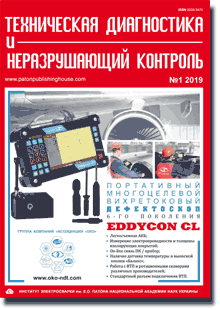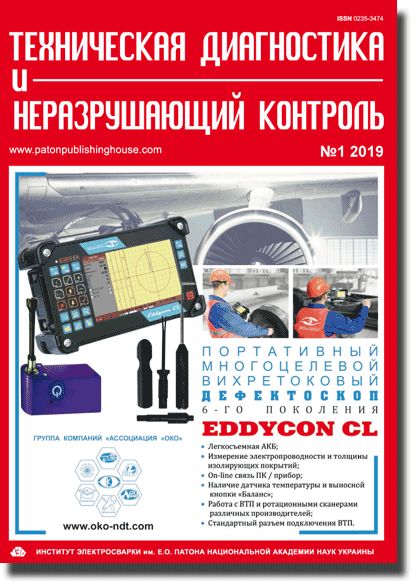Access for download PDF files for subscribers and for reviewers of scientometric bases.
Organization: Elsevier for content access(PDF files of journals released before 2024 are available for download from the website's archives))
Organization: Elsevier for content access(PDF files of journals released before 2024 are available for download from the website's archives))
| 2019 №01 (01) |
DOI of Article 10.15407/tdnk2019.01.02 |
2019 №01 (03) |

Technical Diagnostics and Non-Destructive Testing №1, 2019, стр. 13-25
Statistical analysis of residual strength of defective pipelinesin high-temperature service
A.S. Milenin, E.A. Velikoivanenko, G.F. Rozynka, N.I. Pivtorak
E.O. Paton Electric Welding Institute of the NAS of Ukraine. 11 Kazimir Malevich Str., 03150, Kyiv, Ukraine.E-mail: office @paton.kiev.ua
Abstract:
A numerical procedure of analysis of residual static strength and performance, allowing for defects of corrosion-erosion loss of metal detected during technical diagnostics, was proposed for welded pipeline elements and pressure vessels, operating at higher temperatures. For analysis of non-uniform stress-strain state in the region of the geometrical stress-raiser, alongside the universally accepted statistical mechanics approaches, consisting in evaluation of fracture probability by integration of the stress field within Weibull distribution, an approach of similar consideration of the field of plastic deformation intensity was proposed. This allows correct evaluation of the kinetics of simultaneous development of irreversible deformations of instantaneous plasticity and creep, which determines the limiting state of the defective structure under the impact of a specific system of operational temperature-force impact. This methodology was realized on the base of a complex of finite-element models for prediction of simultaneous development of the stress-strain state and subcritical damage of pipeline elements with surface metal loss defects. For adequate quantitative prediction of the probability of failure of defective pipelines from different materials, values of Weibull parameters were obtained, depending on the material properties and temperature. Equivalence diagrams of admissibility of the defect of local wall thinning of a pipeline element under different operational conditions were derived. Correspondence of the proposed procedures to the requirements of current normative documents is shown. 20 Ref., 13 Fig.
Keywords: pipeline element, corrosion-erosion defect, static strength, tough fracture, fracture probability
Received: 25.02.2019 25
Published: 06.03.2019
1. Berezina, T.G., Bugai, N.V., Trunin, I.I. (1991) Diagnostics and prediction of fatigue life of metal of thermal power plants. Kiev, Tekhnika [in Russian].
2. Xue J.-L., Zhou C.-Y., Peng J. (2015) Ultimate creep load and safety assessment of P91 steel pipe with local wall thinning at high temperature. International Journal of Mechanical Sciences, 93, 136–153. https://doi.org/10.1016/j.ijmecsci.2015.01.010
3. Milenin A., Velikoivanenko E., Rozynka G., Pivtorak N. (2019) Probabilistic procedure for numerical assessment of corroded pipeline strength and operability. International Journal of Pressure Vessels and Piping, 171, 60–68. https://doi.org/10.1016/j.ijpvp.2019.02.003
4. Lemaitre J., Desmorat R. (2005) Engineering Damage Mechanics. Ductile, Creep, Fatigue and Brittle Failures. Berlin, Springer-Verlag.
5. Radaj D. (1992) Heat Effects of Welding. Temperature Field, Residual Stress, Distortion. Berlin, Springer Verlag.
6. Makhnenko V. (2013). Problems of examination of modern critical welded structures. The Paton Welding J., 5, 21–28.
7. Wei Y., Zhang L., Au F.T.K. et al. (2016) Thermal creep and relaxation of prestressing steel. Construction and Building Materials, 128, 118–127. https://doi.org/10.1016/j.conbuildmat.2016.10.068
8. Lemaitre J., Chaboche J.L. (1988) Mecanique des Materiaux Solides. English edition. Cambridge, Cambridge Univ. Press.
9. Makhnenko, V.I. (1976) Design methods of investigation of the kinetics of welding stresses and strains. Kiev, Naukova Dumka [in Russian].
10. Xue L. (2008) Constitutive modeling of void shearing effect in ductile fracture of porous materials. Engineering Fracture Mechanics, 75, 3343–3366.. https://doi.org/10.1016/j.engfracmech.2007.07.022
11. Cowper, G.R., Symonds, P.S. (1958) Strain Hardening and Strain Rate Effects in the Impact Loading of Cantilever Beams. Brown Univ. Applied Mathematics Report.
12. Huang Y. (1991). Accurate dilatation rate for spherical voids in triaxial stress fields. Journal of Applied Mechanics (ASME Transactions), 58, 1084–1086. https://doi.org/10.1115/1.2897686
13. Makhnenko, V.I. (2006) Safe operating life of welded joints and assemblies of modern structures. Kiev, Naukova Dumka [in Russian].
14. Velikoivanenko E., Milenin A., Rozynka G., Pivtorak N. (2015) Evaluation of operability of the main pipeline with local wall thinning at repair by arc surfacing. The Paton Welding Journal, 1, 18–23. https://doi.org/10.15407/tpwj2015.01.03
15. Moshayedi H., Sattari-Far I. (2017). The dependence of Weibull parameters on preloads and its implication on brittle fracture probability prediction using a local criterion. Theoretical and Applied Fracture Mechanics, 87, 50–60. https://doi.org/10.1016/j.tafmec.2016.10.005
16. Qian G., Niffenegger M. (2013) Procedures, methods and computer codes for the probabilistic assessment of reactor pressure vessels subjected to pressurized thermal shocks. Nuclear Engineering and Design, 258, 35–50. https://doi.org/10.1016/j.nucengdes.2013.01.030
17. Velikoivanenko E.A., Milenin A.S., Popov A.V. et al. (2014) Methods and Technologies of Parallel Computing for Mathematical Modeling of Stress-Strain State of Constructions Taking into Account Ductile Fracture. Journal of Automation and Information Sciences, 46, 11, 23–35. https://doi.org/10.1615/JAutomatInfScien.v46.i11.30
18. Velikoivanenko E.A., Milenin A.S., Popov A.V. et al. (2019) Methods of Numerical Forecasting of Serviceability of Welded Structures on Computers of Hybrid Architecture. Cybernetics and Systems Analysis, 55, 1, 117–127. https://doi.org/10.1007/s10559-019-00117-8
19. Bjornoy O. (еd.) (2004) Recommended Practice, DNV-RP-F101. Corroded Pipelines. Hovik, Det Norske Veritas.
20. (2008) DSTU N B V.2.3-21:2008. Guidelines. Determination of the remaining strength of trunk pipelines containing defects. Kyiv, Minregionbud Ukrainy [in Ukrainian].
The cost of subscription/purchase order journals or individual articles
| Journal/Currency | Annual Set | 1 issue printed |
1 issue |
one article |
| TPWJ/USD | 384 $ | 32 $ | 26 $ | 13 $ |
| TPWJ/EUR | 348 € | 29 € | 24 € | 12 € |
| TPWJ/UAH | 7200 UAH | 600 UAH | 600 UAH | 280 UAH |
| AS/UAH | 1800 UAH | 300 UAH | 300 UAH | 150 UAH |
| AS/USD | 192 $ | 32 $ | 26 $ | 13 $ |
| AS/EUR | 180 € | 30 € | 25 € | 12 € |
| SEM/UAH | 1200 UAH | 300 UAH | 300 UAH | 150 UAH |
| SEM/USD | 128 $ | 32 $ | 26 $ | 13 $ |
| SEM/EUR | 120 € | 30 € | 25 € | 12 € |
| TDNK/UAH | 1200 UAH | 300 UAH | 300 UAH | 150 UAH |
| TDNK/USD | 128 $ | 32 $ | 26 $ | 13 $ |
| TDNK/EUR | 120 € | 30 € | 25 € | 15 € |
AS = «Automatic Welding» - 6 issues per year;
TPWJ = «PATON WELDING JOURNAL» - 12 issues per year;
SEM = «Electrometallurgy Today» - 4 issues per year;
TDNK = «Technical Diagnostics and Non-Destructive Testing» - 4 issues per year.





